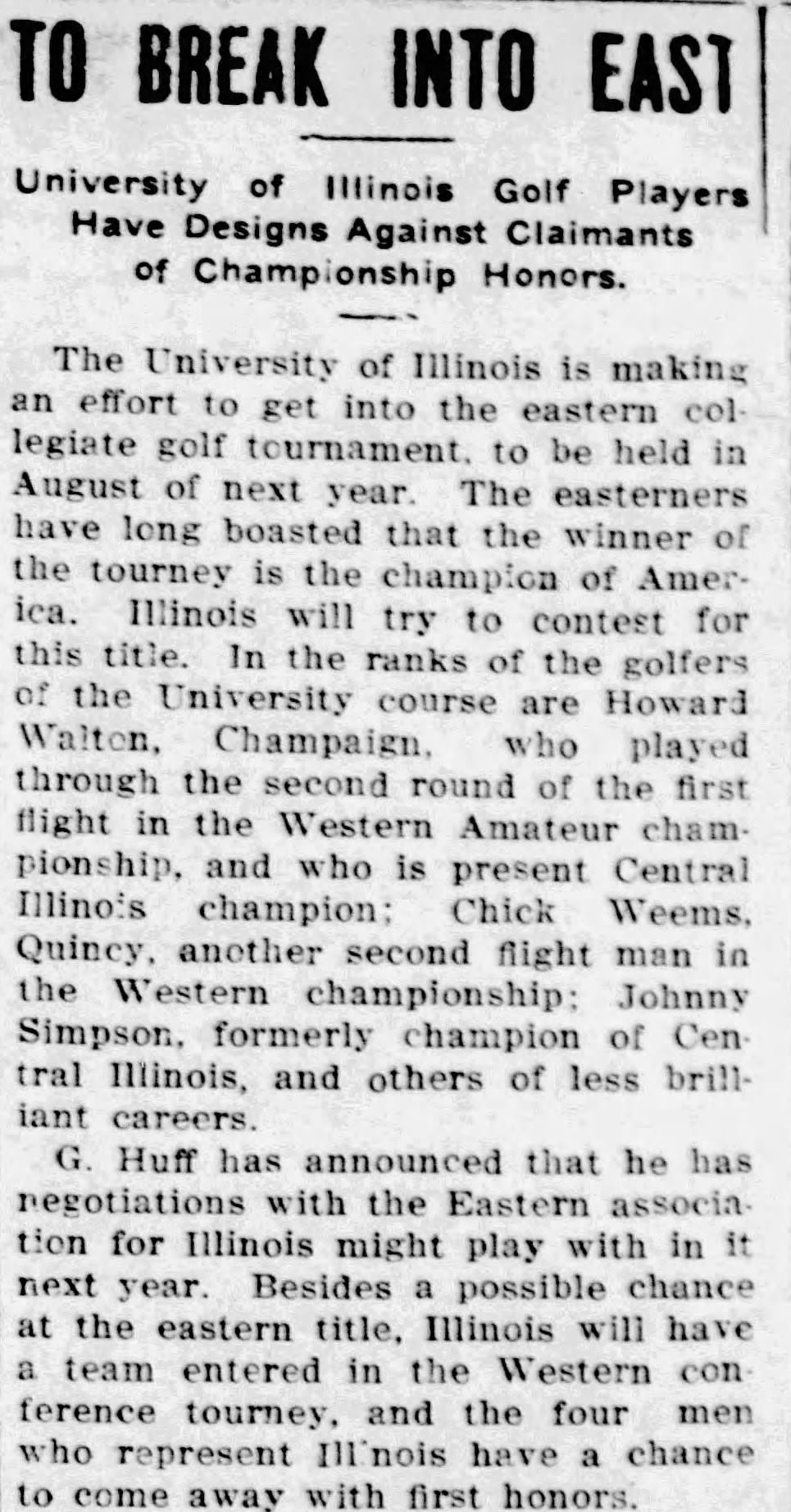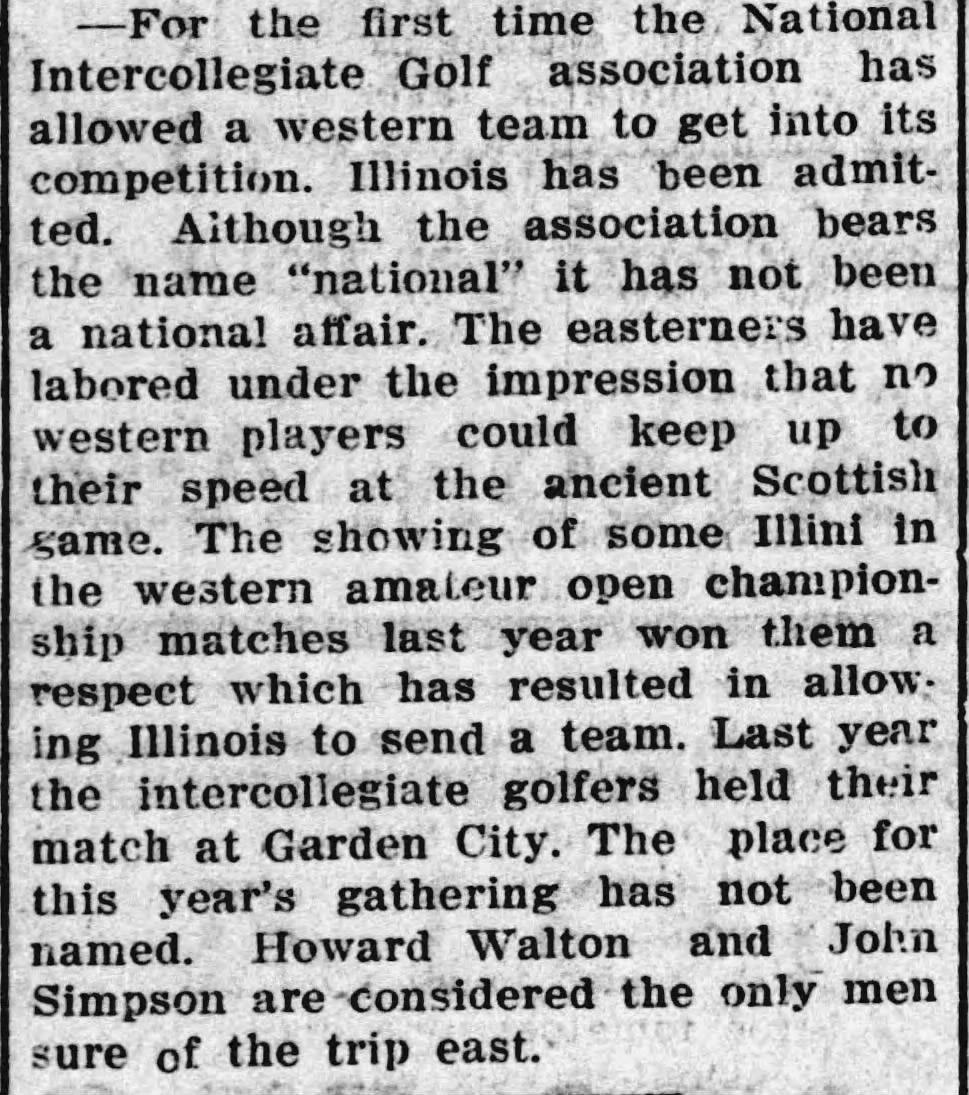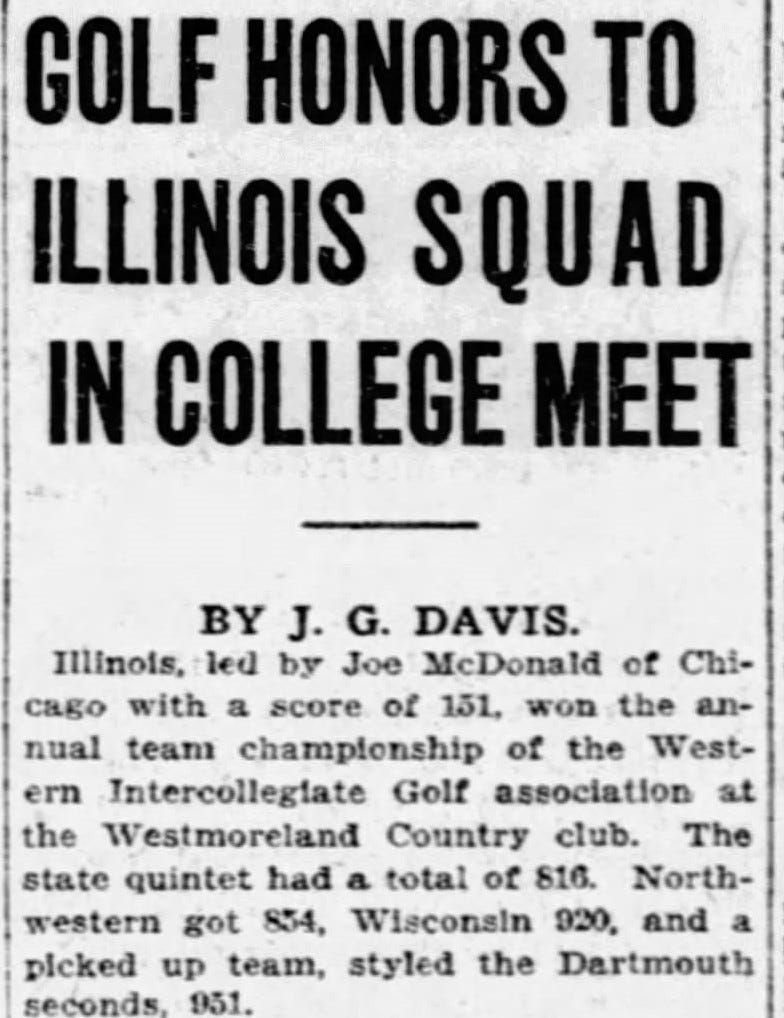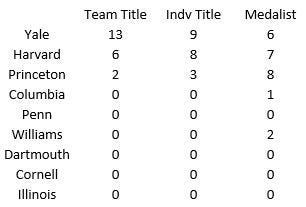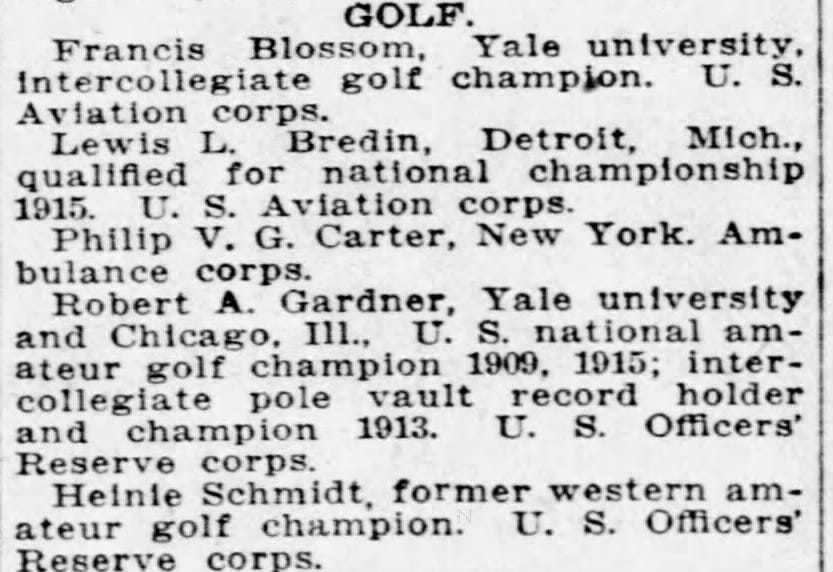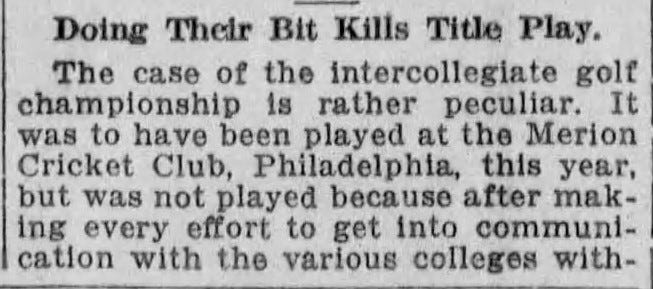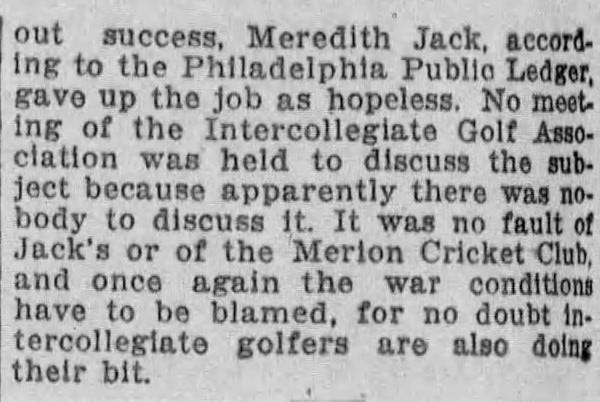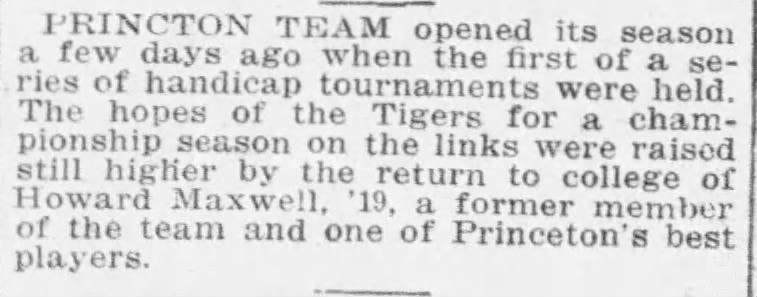This is part of a series on the Men’s Collegiate Championships
IGA Championship Era: 1897-1938
The theme of the 1916 championship: western expansion. What changed since the infamous 1910 championship?
After leaving Northwestern in 1911, Chick Evans continued to prove on the national stage that he was one of the best golfers in the country. In the years following, more and more of the young “Western” golfers (most from the Mid-West) made their way to the Eastern schools which had the dual effect of showcasing the talent from that part of the country and making the Eastern schools more aware of the legitimate collegiate programs there, which had finally established the Western Intercollegiate Golf Association (WIGA) at the end of 1912.
WIGA Championship results
1913:
Chicago (host) won followed by Illinois and Wisconsin
Charles Grimes (Chicago) won individual match play title
1914:
Chicago (host) won followed by Wisconsin, Illinois defaulted with only 2 players showing
decided to finish in one day due to weather so stroke play only - Joe McDonald (Chicago) won individual title as the medalist
Illinois actively seeks to join the IGA
1915:
Illinois def Chicago (host) in an 18-hole playoff after the 36-hole medal play where Northwestern finished 3rd and Wisconsin finished 4th
John Simpson (Illinois) won individual match play title
Illinois team is successful in their campaign to enter the IGA
unlucky to draw Yale in the first round who were on a revenge tour having ended their title streak at 9 straight the previous year when Princeton shocked everyone by first beating (a depleted) Yale in the Semis then Harvard in the Finals to be the first team outside of those two to earn the title
John Simpson qualified for individual MP but was put out in the first round by Davidson Herron
1916: (two weeks before the IGA championship)

Intercollegiate Championship #21: Sep 14-20, 1916
Host: Oakmont CC (Oakmont, PA)
Three years before he would defeat Bobby Jones to win the US Amateur at his home course of Oakmont Country Club, (S) Davidson Herron [Princeton] was the secretary of the IGA and likely at least partially responsible for the collegiate championship making its way out West for the first time.
Format
Team match play (7 teams, 6 players each, random draw)
morning four-ball, afternoon singles
**NOTE: the order of playing four-ball and singles was changed after the 1910 championship when realizing that the team match could be decided before the afternoon with morning singles
Individual stroke play qualifier (18 holes)
19 players WD due to the high winds
Individual match play (16 players, random draw, 18 hole matches)
Results
Team Champ: Princeton (2)
For the second time in three years, Princeton defeated Yale in the Semifinals and then Harvard in the Finals to earn the team championship. The two matchups were the complete opposite types of victories for Princeton, defeating Yale by the narrowest margin (5-4, Howard Maxwell Jr draining a 15 foot putt to secure the winning point against reigning champ Francis Blossom) and Harvard by the widest possible (9-0). The most surprising result of the team championship was Cornell defeating Illinois in the Preliminary round by taking the morning four-ball 2-1 and then splitting the afternoon singles.
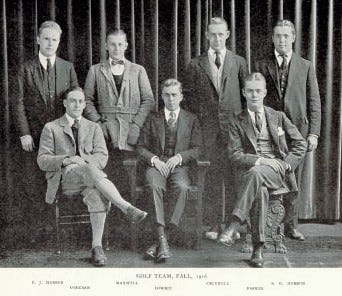
Medalist: (Samuel) Davidson Herron [Princeton]
Davidson Herron toured his home course in 39-41=80 to take medalist honors over both a strong field and strong winds. Conditions were so bad that there were more withdrawals (19) than players qualifying for match play (16), pushing most qualifying scores to their highest mark since 1911. Incredibly, all four Illinois players qualified.

SIDE NOTE: In 1910, Northwestern freshman Chick Evans was widely considered one of the best amateur golfers in the country, but was prevented from competing for an individual collegiate championship. This year, seemingly without any changes in the IGA bylaws, three Northwestern players were allowed to compete as individuals even though Northwestern had not yet joined the IGA. One of these three was the current WIGA individual champion, Fred C Stiles. All three players were among those 19 who ultimately withdrew during qualifying, Stiles after taking an 11 on the second hole.
Individual Champ: James W Hubbell [Harvard]
Finalists D Clark Corkran (Princeton) and James Hubbell (Harvard) took similar paths through the bracket to reach their final match. Both defeated a Princeton player in the Quarterfinals, Hubbell downing Howard Maxwell Jr while Corkran defeated local and tournament favorite (and teammate) Davidson Herron. In the Semifinals, Hubbell continued to surprise the pundants by defeating the Illinois captain Chick Weems, while Corkran took care of business against the other remaining Illini, Joe McDonald.
Corkran was the clear Finals favorite, coming off his recent appearance in the US Amateur Semifinals where he lost to eventual champ Chick Evans 3&2, as well as the fact that this matchup was a repeat of one of the Team Finals singles match which Corkran won 2&1. Given little chance to win by either spectators or his Harvard teammates (who had already left for home), it was not surprising to find that Hubbell was down by 4 holes after the morning round. The lead was stretched to 6 holes early in the afternoon round when things took a sudden turn. The momentum shifted hard in Hubbell’s favor as he was able to erase the lead by taking six straight holes. The match actually made it to the 18th (36th) green where Hubbell’s bogey was good enough for the halve which secured the 1up victory.
In one of those crazy coincidences, JW Hubbell would eventually return home to the Des Moines, IA area and become one of the founding members of local Wakonda CC, site of the 1939 championship which was the first hosted by the NCAA.
Championship Award Count
EXTRA HOLES: The first golf transfer?
Although (and possibly because) the University of Chicago had helped realize the eventual development of the WIGA, it was the University of Illinois that made the big push to join the IGA, becoming the first western team to play in the latter championship in 1915. This development seems to have been a/the motivating factor in one of Chicago’s strongest players and 1914 WIGA individual champ, Joe McDonald, transferring to Illinois to join their golf team in early 1916. As seen above, McDonald would prove to be a major addition to the Illinois squad, helping the team repeat as WIGA champions, finishing runner-up individually in WIGA championship, and making it to the IGA semifinals. Just as interesting, McDonald transferred into the spot left vacant by Howard Walton who himself had transferred to Penn for unspecified (but likely academic) reasons. Walton was the captain of the 1915 Illini team which lost to Yale in team play and he failed to qualify for individual match play. As a member of the Penn team in 1916, Walton became the first player to appear in the championship for two different teams, and unfortunately suffered the same results with a team loss to Yale and missing out on individual match play.
EXTRA HOLES: College Golf Goes to War
War had already been on the minds of many people throughout the country at the time of the 1916 championship. With the US officially entering the “Great War” in the early parts of 1917, many of the college boys would do their part by enlisting in the various armed forces.
With everyone leaving, the championship was cancelled by default in 1917 when representatives from Merion CC, prospective host for the upcoming championship, found that all of the IGA representatives were consumed by the war effort. Despite the best efforts of Columbia University - led by captain and team champion A.L. Walker - who sent out letters to the schools trying to rekindle interest, the 1918 IGA championship was also cancelled. This would be the last time a championship was not held until the infamous 2020 COVID season.
One of the very few (two?) players who would return from the war and resume their collegiate golf career after the two-year absence was Princeton’s Howard Maxwell Jr who played a crucial part of Princeton’s 1916 team championship. Remember the Maxwell name as it will soon (next post) become immortalized in college golf history.
Thanks for reading!
Up Next:
In the next post we will cover. . . well, frankly just too much. Our 10th entry in this series will be an extra-long one in order to touch on: college golf returning from the war, changing seasons, new formats, new hardware, the birth of conference golf, and the curious case of Bobby Jones never playing for an intercollegiate championship.





